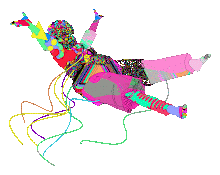20071023
the majestic giant planet and his rings
eclipsed to death by
...and you will know us by the trail of dead
@
23.10.07
0
eclipses
![]()
tags: saturn, spacecraft
20071021
jupiter ahead !

The New Horizons spacecraft took some stunning images of Jupiter earlier this year while on the way out to Pluto. Famous for its Great Red Spot, Jupiter is also known for its regular, equatorial cloud bands, visible through even modest sized telescopes.
The above image was taken near Jupiter's terminator, and shows that the Jovian giant possibly has the widest diversity of cloud patterns in our Solar System. On the far left are clouds closest to Jupiter's south pole. Here turbulent whirlpools and swirls are seen in a dark region, dubbed a belt, that rings the planet. Even light colored regions, called zones, show tremendous structure, complete with complex wave patterns. The energy that drives these waves likely comes from below.
New Horizons is the fastest space probe ever launched, and is zipping through the Solar System on track to reach Pluto in 2015.
eclipsed to death by
...and you will know us by the trail of dead
@
21.10.07
0
eclipses
![]()
tags: jupiter, spacecraft
20071009
the red face of andromeda
NASA's Spitzer Space Telescope has captured stunning infrared views of the famous Andromeda galaxy to reveal insights that were only hinted at in visible light.
Spitzer's 24-micron mosaic (top panel) is the sharpest image ever taken of the dust in another spiral galaxy. This is possible because Andromeda is a close neighbor to the Milky Way at a mere 2.5 million light-years away.
The Spitzer multiband imaging photometer's 24-micron detector recorded 11,000 separate snapshots to create this new comprehensive picture. Asymmetrical features are seen in the prominent ring of star formation. The ring appears to be split into two pieces, forming the hole to the lower right. These features may have been caused by interactions with satellite galaxies around Andromeda as they plunge through its disk.
Spitzer also reveals delicate tracings of spiral arms within this ring that reach into the very center of the galaxy. One sees a scattering of stars within Andromeda, but only select stars that are wrapped in envelopes of dust light up at infrared wavelengths.
This is a dramatic contrast to the traditional view at visible wavelengths (lower left panel), which shows the starlight instead of the dust. The center of the galaxy in this view is dominated by a large bulge that overwhelms the inner spirals seen in dust. The dust lanes are faintly visible in places, but only where they can be seen in silhouette against background stars.
The multi-wavelength view of Andromeda (lower right panel) combines images taken at 24 microns (blue), 70 microns (green), and 160 microns (red). Using all three bands from the multiband imaging photometer allows astronomers to measure the temperature of the dust by its color. The warmest dust is brightest at 24 microns while the coolest is most evident at 160 microns. The blue/white areas have the hottest dust, as seen in the bulge and in the star-forming areas along the arms. The cooler dust floating further out in the ring and arms are in the redder regions.
The data were taken on August 25, 2004, the one-year anniversary of the launch of the space telescope. The observations have been transformed into this remarkable gift from Spitzer -- the most detailed infrared image of the spectacular galaxy to date.
eclipsed to death by
...and you will know us by the trail of dead
@
9.10.07
0
eclipses
![]()
tags: andromeda, galaxy, spacecraft
your path to divinity
eclipsed to death by
...and you will know us by the trail of dead
@
9.10.07
0
eclipses
![]()
tags: aurora borealis, earth
a hole in mars
In a close-up from the HiRISE instrument onboard the Mars Reconnaissance Orbiter, this mysterious dark pit, about 150 meters across, lies on the north slope of ancient martian volcano Arsia Mons. Lacking raised rims and other impact crater characteristics, this pit and others like it were originally identified in visible light and infrared images from the Mars Odyssey and Mars Global Surveyor spacecraft.
While the visible light images showed only darkness within, infrared thermal signatures indicated that the openings penetrated deep under the martian surface and perhaps were skylights to underground caverns. In this later image, the pit wall is partially illuminated by sunlight and seen to be nearly vertical, though the bottom, at least 78 meters below, is still not visible. The dark martian pits are thought to be related to collapse pits in the lava flow, similar to Hawaiian volcano pit craters.
eclipsed to death by
...and you will know us by the trail of dead
@
9.10.07
0
eclipses
![]()
tags: mars, spacecraft
the pioneer
eclipsed to death by
...and you will know us by the trail of dead
@
9.10.07
0
eclipses
![]()
tags: russia, spacecraft, sputnik








